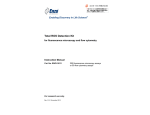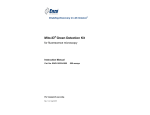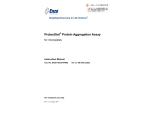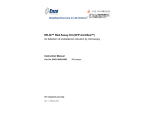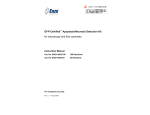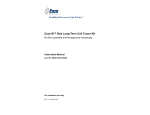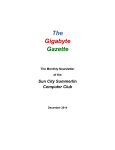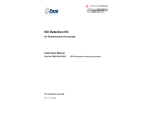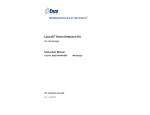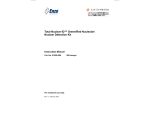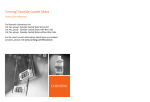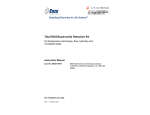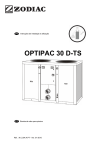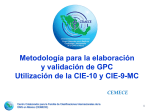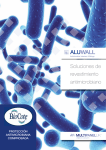Download User Manual-ENZ-51028-K100
Transcript
※本プロトコールは参考用の資料になり ます。商品ご購入の際は必ず商品に添付 されている資料をご参照ください。 Enabling Discovery in Life Science® Golgi-ID™ Green Assay Kit for detection of Golgi bodies by microscopy Instruction Manual Cat. No. ENZ-51028-K100 For research use only. Rev. 1.0 March 2010 for 100 assays Notice to Purchaser The Golgi-ID Green Assay Kit is a member of the CELLestial® product line, reagents and assay kits comprising fluorescent molecular probes that have been extensively benchmarked for live cell analysis applications. CELLestial® reagents and kits are optimal for use in demanding cell analysis applications involving confocal microscopy, flow cytometry, microplate readers and HCS/HTS, where consistency and reproducibility are required. This product is manufactured and sold by ENZO LIFE SCIENCES, INC. for research use only by the end-user in the research market and is not intended for diagnostic or therapeutic use. Purchase does not include any right or license to use, develop or otherwise exploit this product commercially. Any commercial use, development or exploitation of this product or development using this product without the express prior written authorization of ENZO LIFE SCIENCES, INC. is strictly prohibited. Limited Warranty This product is offered under a limited warranty. The product is guaranteed to meet appropriate specifications described in the package insert at the time of shipment. Enzo Life Sciences’ sole obligation is to replace the product to the extent of the purchase price. All claims must be made to Enzo Life Sciences, Inc. within five (5) days of receipt of order. Trademarks and Patents Enzo, CELLestial and Golgi-ID are trademarks of Enzo Life Sciences, Inc. Several of Enzo’s products and product applications are covered by US and foreign patents and patents pending. Contents I. Introduction ............................................................... 1 II. Reagents Provided and Storage.............................. 2 III. Additional Materials Required ................................. 2 IV. Safety Warnings and Precautions........................... 3 V. Methods and Procedures ......................................... 3 A. REAGENT PREPARATION .............................................. 3 B. STAINING LIVE, ADHERENT CELLS ............................... 4 C. STAINING LIVE CELLS GROWN IN SUSPENSION ............ 5 D. STAINING ALDEHYDE FIXED CELLS ............................... 5 VI. Appendices ............................................................... 6 A. FILTER SET SELECTION ............................................ 6 B. RESULTS ................................................................. 7 VII. References ................................................................ 7 VIII. Troubleshooting Guide ........................................... 8 I. Introduction Enzo Life Sciences’ Golgi-ID™ Green Assay Kit contains a Golgi apparatus -selective dye suitable for live cell, or aldehyde-fixed cell staining. Compared with other commercially available dyes for labeling Golgi bodies, Golgi-ID™ Green dye is more faithfully localized to the target organelle, with minimal staining of the endoplasmic reticulum.(1) Micromolar concentrations of Golgi-ID™ Green dye are sufficient for staining mammalian cells, as validated with human cervical carcinoma cell line HeLa, human T-lymphocyte cell line, Jurkat, canine kidney cell line MDCK, and human bone osteosarcoma epithelial cell line U2OS. One important application of Golgi-ID™ Green dye is in fluorescence co-localization imaging with red fluorescent protein (RFP)-tagged proteins. This is a powerful approach for determining the targeting of molecules to intracellular compartments and for screening of their associations and interactions. Many organelle-targeting probes photo-bleach rapidly, are subject to quenching upon concentration in organelles, are highly toxic or only transiently associate with the target organelle, requiring imaging within a minute or two of dye addition. Consequently, Golgi-ID™ Green dye, a new green-emitting, cell-permeable small molecule organic probe that spontaneously localizes to live or fixed Golgi apparatus, was developed. Golgi-ID™ Green dye can be readily used in combination with other common UV and visible light excitable organic fluorescent dyes and various fluorescent proteins in multicolor imaging and detection applications. The dye emits in the FITC region of the visible light spectrum, and is resistant to photo-bleaching, concentration quenching and photo-conversion. The kit should also be suitable for identifying Golgi body perturbing agents and thus can be a useful tool for examining retrograde flow mechanisms in cellular secretory pathways.(2) The Golgi-ID™ Green Assay Kit has been specifically designed for use with RFP-expressing cell lines as well as cells expressing blue, cyan or orange fluorescent proteins (BFPs, CFPs, OFPs). Additionally, the kit is suitable for use with live or fixed cells in conjunction with probes, such as labeled antibodies, or other fluorescent conjugates displaying similar spectral properties as Texas Red, or coumarin. A blue nuclear counterstain, Hoechst 33342, is provided to highlight this organelle as well. 1 II. Reagents Provided and Storage All reagents are shipped on dry ice. Upon receipt, the kit should be stored upright and protected from light at ≤-20°C. When stored properly, these reagents are stable for at least twelve months. Avoid repeated freezing and thawing. Reagents provided in the kit are sufficient for 100 microscopy assays using live cells (adherent or in suspension). Reagent Quantity Golgi-ID™ Green Detection Reagent 50 nmoles Hoechst 33342 Nuclear Stain 50 µL 10X Assay Buffer 1 15 mL 50X Assay Buffer 2 1.2 mL III. Additional Materials Required Standard fluorescence microscope Calibrated, adjustable precision pipets, preferably with disposable plastic tips Adjustable speed centrifuge with swinging buckets (for suspension cultures) Glass microscope slides Glass cover slips Deionized water Anhydrous DMSO (optional). Growth medium (e.g. Dulbecco’s Modified Eagle medium, D-MEM) Paraformaldehyde (optional, for fixation protocol) PBS (optional, for fixation protocol) 2 IV. Safety Warnings and Precautions This product is for research use only and is not intended for diagnostic purposes. Some components of this kit may contain hazardous substances. Reagents can be harmful if ingested or absorbed through the skin and may cause irritation to the eyes. They should be treated as possible mutagens, should be handled with care and disposed of properly. Observe good laboratory practices. Gloves, lab coat, and protective eyewear should always be worn. Never pipet by mouth. Do not eat, drink or smoke in the laboratory areas. All blood components and biological materials should be treated as potentially hazardous and handled as such. They should be disposed of in accordance with established safety procedures. To avoid photobleaching, perform all manipulations in low light environments or protected from light by other means. V. Methods and Procedures NOTE: PLEASE READ THE ENTIRE PROCEDURE BEFORE STARTING. Allow all reagents to thaw at room temperature before starting with the procedures. Upon thawing, gently hand-mix or vortex the reagents prior to use to ensure a homogenous solution. Briefly centrifuge the vials at the time of first use, as well as for all subsequent uses, to gather the contents at the bottom of the tube. A. REAGENT PREPARATION 1. 1X Assay Solution Allow the 10X Assay Buffer 1 and the 50X Assay Buffer 2 to warm to room temperature. Make sure that the reagents are free of any crystallization before use. Prepare enough 1X Assay Solution for the number of samples to be assayed. For each 10 mL preparation of 1X Assay Solution, add 1 mL 10X Assay Buffer 1 and 0.2 mL 50X Assay Buffer 2 into 8.8 mL deionized water. Mix well. 2. 100X Golgi-ID™ Green Dye Solution Add 100 µL of the 1X Assay Solution prepared above to the vial containing lyophilized Golgi-ID™ Green Detection Reagent (50 nmoles). Vortex gently or slowly rotate the tube to dissolve. 3 3. Dual Detection Reagent The concentration of Golgi-ID™ Green dye for optimal staining will vary depending upon the application. Suggestions are provided to use as guidelines, though some modifications may be required depending upon the particular cell type employed and other factors such as the permeability of the dye to the cells or tissues. To reduce potential artifacts from overloading of the cells, the concentration of the dye should be kept as low as possible. Prepare sufficient amount of Dual Detection Reagent for the number of samples to be assayed as follows: For every milliliter of 1X Assay Solution (see preparation in section V-A1), add 10 µL of the 100X Golgi-ID™ Green Dye Solution (from section V-A2) and 1 µL of Hoechst 33342 Nuclear Stain. NOTE: (a) The dyes may be combined into one staining solution or each may be used separately, if desired. (b) The Hoechst 33342 Nuclear Stain can be diluted further if its staining intensity is much stronger than the green Golgi stain. (c) When staining BFP- or CFP-expressing cells, the Hoechst 33342 Nuclear Stain should be omitted due to its spectral overlap with these fluorescent proteins. 4. 4% Formaldehyde Solution The following procedure is for preparation of 10 mL of 4% formadehyde solution: Dilute 0.4 gram paraformaldehyde to a final volume of 10 mL with PBS. Mix well. B. STAINING LIVE, ADHERENT CELLS 1. Grow cells on coverslips inside a Petri dish filled with the appropriate culture medium. When the cells have reached the desired level of confluence, carefully remove the medium. 2. Wash the cells with 100 µL 1X Assay Solution (from section V-A1, page 3). 3. Dispense sufficient volume of Dual Detection Reagent (see section V-A3, above) to cover the monolayer cells (~100 μL for cells grown on an 18 X 18 mm coverslip). 4. Protect samples from light and incubate for 30 minutes at 4°C. 5. Wash the cells 3 times using 100 µL ice cold medium for each wash. 6. Incubate the cells in medium at 37°C for 30 minutes. 7. Wash the cells with 100 μL 1X Assay Solution. Remove excess buffer and place coverslip on slide. 4 8. Analyze the stained cells by wide-field fluorescence or confocal microscopy (60X magnification recommended). Use a standard FITC filter set for imaging the Golgi bodies. Optionally, image the nucleus using a DAPI filter set and the RFP-tagged protein using a Texas Red filter set. C. STAINING LIVE CELLS GROWN IN SUSPENSION 1. Centrifuge cells for 5 minutes at 400 x g at room temperature (RT) to obtain a cell pellet. 2. Carefully remove the supernatant by aspiration and then wash the cells with 200 µL of 1X Assay Solution (from section V-A1, page 3). 3. Carefully remove the supernatant by aspiration and then add 100 µL of Dual Detection Reagent (see section V-A3, page 4) to the cell pellet. 4. Protect samples from light and incubate for 30 minutes on ice. 5. Wash the cells 2 times using 200 µL ice cold medium for each wash. 6. Re-suspend the cells in 100 µL ice cold medium and then incubate the cells at 37°C for 30 minutes. 7. Wash the cells with 200 μL 1X Assay Solution. 8. Re-suspend cells in 100 μL 1X Assay Solution, then transfer the cells to a glass slide and overlay with a coverslip. 9. Analyze the stained cells by wide-field fluorescence or confocal microscopy (60X magnification recommended). Use a standard FITC filter set for imaging the Golgi bodies. Optionally, image the nucleus using a DAPI filter set and the RFP-tagged protein using a Texas Red filter set. D. STAINING ALDEHYDE FIXED CELLS 1. Grow cells on coverslips inside a Petri dish filled with the appropriate culture medium. When the cells have reached the desired level of confluence, carefully remove the medium. 2. Wash the cells with 100 µL 1X Assay Solution. 3. Fix the cells for 10 minutes at 37°C with 4% formaldehyde solution (see section V-A4, page 4). 4. Wash the cells 3 times using 100 µL ice cold 1X Assay Solution for each wash. 5. Dispense sufficient volume of Dual Detection Reagent (see section V-A3, page 4) to cover the monolayer cells (~100 μL for cells 5 grown on an 18 X 18 mm coverslip). 6. Protect samples from light and incubate for 30 minutes at 4°C. 7. Wash the cells 3 times using 100 µL 1X Assay Solution for each wash. 8. Add 100 µL fresh medium to cover the cells and allow to incubate at room temperature for 45 minutes. 9. Wash the cells with 100 µL 1X Assay Buffer. Remove excess buffer and place coverslip on slide. 10. Analyze the stained cells by wide-field fluorescence or confocal microscopy (60X magnification recommended). Use a standard FITC filter set for imaging the Golgi bodies. Optionally, image the nucleus using a DAPI filter set and the RFP-tagged protein using a Texas Red filter set. NOTE: Avoid the use of detergents and ethanol/methanol/acetone fixatives. VI. APPENDICES A. FILTER SET SELECTION The selection of optimal filter sets for a fluorescence microscopy application requires matching the optical filter specifications to the spectral characteristics of the dyes employed in the analysis. Consult the microscope or filter set manufacturer for assistance in selecting optimal filter sets for your microscope. B 300 350 400 450 500 550 600 650 700 Wavelength (nm) Fluorescence Emission Absorbance Fluorescence Emission Fluorescence Excitation A 200 250 300 350 400 450 500 550 600 Wavelength (nm) Figure 1. Fluorescence excitation and emission spectra for Golgi-ID™ Green dye (panel A) and absorbance and fluorescent emission spectra for Hoechst 33342 dye (panel B). All spectra were determined in 1X Assay Solution. 6 B. RESULTS The Golgi apparatus is an organelle found in eukaryotic cells, responsible for processing and packaging proteins and lipids during their subcellular sorting. One prominent post-translational modification proteins and lipids undergo within the Golgi apparatus is glycosylation through the actions of various glycosidases and transferases. Interfering with Golgi apparatus function by, for example, treatment with certain drugs, typically leads to perturbation of Golgi function, including blocking of secretion, altering morphology, dispersion of Golgi structural elements, loss of cisternal stacks or inhibition of vesicular transport.(2) The Golgi-ID™ Green Assay Kit provides a rapid and convenient method for visualizing the Golgi body within living cells, without a requirement for lengthy transfection procedures. In addition to serving as a live cell permeable dye, Golgi-ID™ Green dye is also localized within the Golgi body of fixed cells. Upon staining with the dual detection reagent, the nucleus should fluoresce blue, as detected with a DAPI filter set, and the Golgi apparatus should exhibit prominent green fluorescence, appearing as a perinuclear reticular network within the cell, when employing a FITC filter set. Only minor staining of other membranes within the cell should be observed. VII. References 1. Deng Y, Bennink JR, Kang HC, Haugland RP, Yewdell JW. Fluorescent conjugates of brefeldin A selectively stain the endoplasmic reticulum and Golgi complex of living cells. J Histochem Cytochem. 1995 Sep;43(9):907-15. 2. Dinter A and Berger EG Golgi-disturbing agents. Histochem Cell Biol. 1998 May-Jun;109(5-6):571-90. 7 VIII. Troubleshooting Guide Problem Potential Cause Suggestion Golgi apparatus is not sufficiently stained. Very low concentration of Golgi-ID™ Green dye was used or cells were incubated too long after labeling. Either increase the labeling concentration or limit the time allowed for the cells to grow after the dye has been removed. We recommend labeling for 30 minutes and incubating cells for 30 minutes after the label has been removed. Precipitate is seen in the 10X Assay Buffer 1. Precipitate forms at low temperatures. Allow solution to warm to room temperature or 37°C, then vortex to dissolve all precipitate. The blue nuclear counterstain is too bright compared to the green Golgi stain. Different microscopes, cameras and filters may make some signals appear very bright. Reduce the concentration of the nuclear counterstain or shorten the exposure time. The green Golgi dye appears to stain more than just the Golgi bodies. Excess Golgi-ID™ Green dye was used or cells were not washed well enough after staining with medium containing serum. Reduce the concentration of Golgi-ID™ green and/or add additional washes with ice cold medium (containing 10% serum) and extend the incubation time in medium after staining. 8 www.enzolifesciences.com Enabling Discovery in Life Science® NORTH/SOUTH AMERICA GERMANY UK & IRELAND ENZO LIFE SCIENCES INTERNATIONAL, INC. 5120 Butler Pike Plymouth Meeting, PA 19462-1202 USA T 1-800-942-0430/(610) 941-0430 F (610) 941-9252 E [email protected] ENZO LIFE SCIENCES GMBH Marie-Curie-Strasse 8 DE-79539 Lörrach Germany T +49/0 7621 5500 526 Toll Free 0800 664 9518 F +49/0 7621 5500 527 E [email protected] www.enzolifesciences.com ENZO LIFE SCIENCES (UK) LTD. Palatine House Matford Court Exeter EX2 8NL UK T 0845 601 1488 (UK customers) T +44/0 1392 825900 (from overseas) F +44/0 1392 825910 E [email protected] www.enzolifesciences.com www.enzolifesciences.com SWITZERLAND & REST OF EUROPE BENELUX FRANCE ENZO LIFE SCIENCES AG Industriestrasse 17, Postfach CH-4415 Lausen Switzerland T +41/0 61 926 89 89 F +41/0 61 926 89 79 E [email protected] www.enzolifesciences.com ENZO LIFE SCIENCES BVBA Melkerijweg 3 BE-2240 Zandhoven Belgium T +32/0 3 466 04 20 F +32/0 3 466 04 29 E [email protected] www.enzolifesciences.com ENZO LIFE SCIENCES c/o Covalab s.a.s. 13, Avenue Albert Einstein FR -69100 Villeurbanne France T +33 472 440 655 F +33 437 484 239 E [email protected] www.enzolifesciences.com














